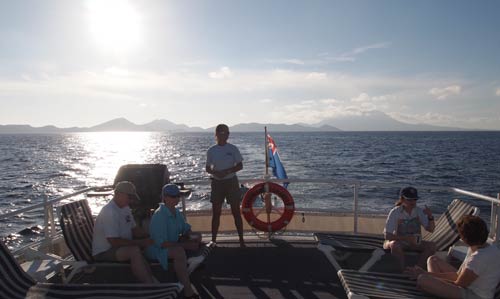This is a review and description of the reasonably priced seven day/seven night "liveaboard" dive trips around the islands of St. Kitts and Saba Explorer Ventures offers on its Caribbean Explorer II where guests can dive to their hearts' content.
Location: Starts from Basseterre Marina on the Northeastern Caribbean island of St. Kitts (or from St. Maarten going the other way).
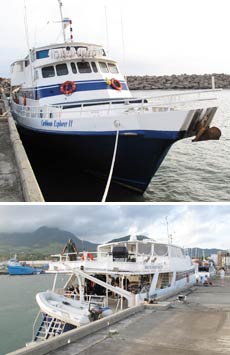 Overall: The Caribbean Explorer II is a 115-foot long liveaboard vessel providing all-inclusive liveaboard dive vacations. Trips start at the Basseterre Marina on the island of St. Kitts and end at the island of Sint Maarten, or vice versa. Diving is divided into St. Kitts and Saba. Dive locations vary, but usually include dives off the eastern and southern coasts of those two islands. Diving off Statia (St. Eustatius), which lies between Saba and St. Kitts, is no longer on the itinerary.
Overall: The Caribbean Explorer II is a 115-foot long liveaboard vessel providing all-inclusive liveaboard dive vacations. Trips start at the Basseterre Marina on the island of St. Kitts and end at the island of Sint Maarten, or vice versa. Diving is divided into St. Kitts and Saba. Dive locations vary, but usually include dives off the eastern and southern coasts of those two islands. Diving off Statia (St. Eustatius), which lies between Saba and St. Kitts, is no longer on the itinerary.
The ship has nine air-conditioned staterooms for a maximum of 18 passengers and usually a crew of about seven, including two or three divemasters. Each room has its own bathroom/shower, the diningroom/salon is on the upper deck in the semi-open (seals with plastic windows), there is a small upper lounging and observation deck, food and drinks (including alcohol) are included, and guests can do up to five dives per day.
Being on a liveaboard is the easiest and most relaxing way to dive because you never have to carry your gear around, and booking a trip on the Caribbean Explorer II, which was built in 1978 and recommissioned as a liveaboard in 1999, is a great way to get in some serious, yet relaxing diving.
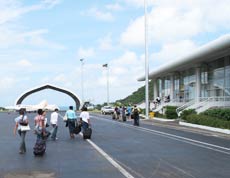 Arrival/customs: On your flight to St. Kitts you fill out two (somewhat confusing) customs documents. Upon arrival at the surprisingly nice and modern St. Kitts airport, immigration and customs are quick and hassle-free. Outside the airport, we were met by the van service that took us to the boat. The van was "island-style," but the short ride from the airport was just US$5/person.
Arrival/customs: On your flight to St. Kitts you fill out two (somewhat confusing) customs documents. Upon arrival at the surprisingly nice and modern St. Kitts airport, immigration and customs are quick and hassle-free. Outside the airport, we were met by the van service that took us to the boat. The van was "island-style," but the short ride from the airport was just US$5/person.
If you arrive the day the Caribbean Explorer leaves port (Saturday), Explorer Ventures will pick you up right at the airport. If you arrive the day (or several days) before, you have to arrange for a hotel to stay. Explorer Ventures will call you at your hotel and arrange for the pickup on Saturday.
Getting to the Marina: The Caribbean Explorer II docks on the right side of the Basseterre harbor/marina that also has a cruise ship dock. The St. Kitts port/marina is pretty beat up (if you start from St. Maarten, that port is a high-octane, entertaining place).
General: For serious divers, the Caribbean Explorer II offers five terrific dives every day, excellent food, adequate space to relax and enjoy the scenery, nice little touches (like freshly baked cookies or hot chocolate when returning from night dives), acceptable cabins and a lounge on the upper deck. All staff was competent and helpful, and we always felt the crew was on top of things.
Below you can see how we're unloading and then boarding the Caribbean Explorer II.
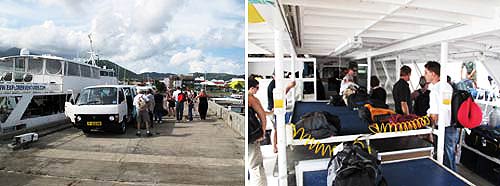
And here are some of the first impressions: A look up and down the main corridor and at the staircase going down to the lower deck where our stateroom was. We'd become quite familiar with those stairs.
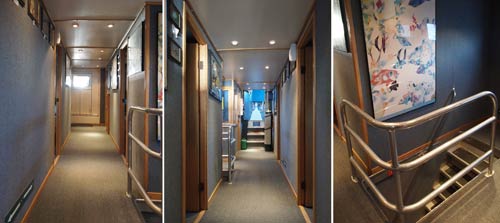
Room: The Caribbean Explorer II has nine staterooms on two decks. The cabins offer a variety of twin, double and queen beds, sometimes on two levels, so do spend some time figuring out what works best for you! We stayed in stateroom 5 on the lower deck, which looked large on the diagram, but was quite cramped and we missed the small desk and closet we'd had on the TC Explorer. There was a bit of storage space under the beds and a few hangers, but not enough. There is an adequate number of American-style 110 Volt outlets for electronic gear (plus a charging station on the dive deck for camera and strobe batteries).
Unfortunately, I neglected to take pictures of all the cabins before they were occupied, and the below only shows our stateroom #5 as it looked when sitting on the bed. Next to it a visual of the main stairway down..
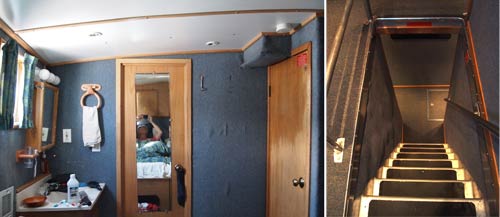
Each cabin has its own bathroom with toilet, sink and shower. They are small but adequate. Everything worked fine and there was plenty of hot water with good water pressure. It's okay to drink the water as it comes from the boat's own onboard reverse osmosis systems. The bathroom has soap, shampoo and conditioner, but no hair dryer. There is no minibar or safe (neither are needed as you can always get what you want from the fridge/bar, and everything is totally safe).
There were plenty of towels. Towels are separated into inside and outside towels, and they are not to be mixed. You never wear shoes inside the ship (they are deposited in a large box when you first board the ship). There is almost no drawer and closet space, and it's best to ask the crew to stow away your luggage and bags in central storage.
The beds were exceptionally comfortable. Maybe it's because you sleep well after four or five dives, but I have hardly slept better. You get two pillows each. The crew makes up your bed while you have breakfast, and in the evening they even put a chocolate candy on your pillow.
Crew: On our trip, we had purser Polly, engineer Scott, dive master Laszlo, stewardess Susan, dive master Brett, cook Jane and captain Ian. They were all friendly, helpful and very competent. The atmosphere was always informal, with the entire crew doing whatever needed to be done, be that helping with service, making beds, answering questions or just hanging out with us. They all made us feel like we were pampered guests on a friend's boat. No language barrier either (unless you have a problem understanding Brit).

Lounge and entertainment: A liveaboard is not a cruise ship, so don't expect shopping, hot tubs or night clubs. The emphasis here is on diving, and there's so much diving that you'll likely be too tired to do anything but hit the sack! The Caribbean Explorer II's common area consists of an upstairs lounge/diningroom that also has a flatscreen TV, a DVD player, and a sound system. There are also books and magazines as well as board and card games. In the background you can see the fridge, coffee machine and soda dispenser.
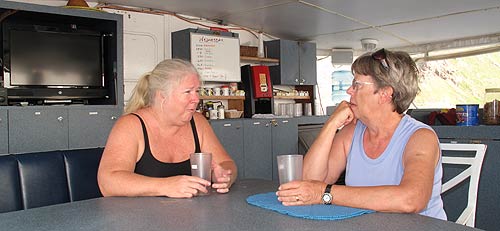
The Caribbean Explorer is a little cramped with a full load and space can quickly run out on the upper sundeck (see below) adjacent to the dining area/lounge. The upper deck, though, is perfect for sunbathing or just hanging out. There are comfortable lounge chairs and stargazing at night is a real treat. Perhaps best of all, you never have to worry about mosquitoes or other bugs. There aren't any!
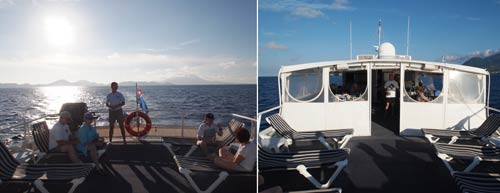
Food/Dining: Eating on the Caribbean Explorer II is buffet style in the dining room/lounge. When we were there, there were three tables with chairs and benchseating for six each. The dining room/salon was somewhat cramped compared to the company's Turks and Caicos boat. All food is prepared on board by chef Jane.
For breakfast, we had items like ham and eggs cooked to order, toast, English muffins, jams and preserves, waffles, pancakes and sausage, omelette, Egg McMuffins, French Toast, etc. There were also always a variety of cereals, really delicious yogurts, as well as milk and fruit juices.
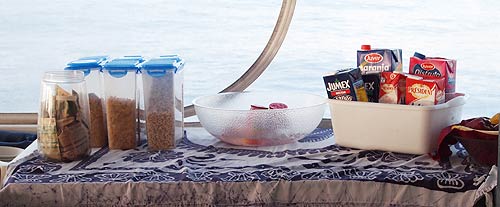
For lunch, we saw tomato soup, pita bread, ham, and some excellent filo dough Spanakopita; marinara sauce with ground beef, chunks of pork tender loin in a white sauce, salad, and vegetables; chicken fajitas, chopped meat, giant tortillas, beans, and all the other trimmings for tacos and burritos; shrimp and pasta with Alfredo and marinara, Cesar salad with excellent croutons (and since -- believing that fish are friends, not food -- we had requested no seafood, the cook made terrific chicken breast for us); hamburgers and hot dogs with all the trimmings; etc.
For dinner, chef Jane treated us to large barbecued steaks, baked potatoes, excellent asparagus, couscous on tomatoes; excellent and very lean pork tenderloins, scalloped potatoes, broccoli, beans; barbecued ribs, cole slaw, and beans; beef stroganoff, rice, broccoli and red cabbage, banana cake with ice cream; a turkey dinner with stuffing, gravy, sweet potatoes, Chicken Parmesan, etc.
Snacks included chocolate chip cookies, cheese and crackers, banana bread, quesadillas, fried cheese sticks, scones and jam, brownies, etc. Food was consistently excellent. Jane did an outstanding job.
Bar/beverages: The vessel has a refrigerator on upper deck that was always fully stocked with beer, milk, juices, lemon slices, and other things. No individual soda cans and the soda from the bar-style soda dispenser (Coke, Diet-Coke, Sprite) was flat. There is red and white wine and a variety of beers, mostly local brews. There also was the usual variety of hard liquor. Wine, beer and liquor was strictly self-serve as the crew is not allowed to serve alcohol.
Suitability as a dive boat: The idea of a liveaboard is to make diving as easy as possible. This includes all the logistics of getting to dive sites, prepping gear, and getting in and out of the water as quickly and easily as possible. The Caribbean Explorer II admirably succeeds in most areas.
The covered dive prep area is on the main deck, with your tank/BC secured in a bracket and with a bungie cord. There's room to put fins and other items under the bench. You never have to move your gear during the entire trip. There is a place for cameras and you can hang your wetsuit on a rack in the center of the deck to dry in the wind. There's an adequate supply of spare parts, tools, batteries and other necessities. With a full boat (18), the space for divers was fairly cramped.

Dive briefings are all done in the lounge on the upper deck. The crew draws maps of the dive site on a white board and uses that to explain the site and the dive plan. One or more of the three dive masters comes along on each dive. Divers can join the dive master, or they are free to go by themselves. I couldn't help but wonder how long it'll be until these briefings are all on flatscreen displays with all sorts of other pertinent data.
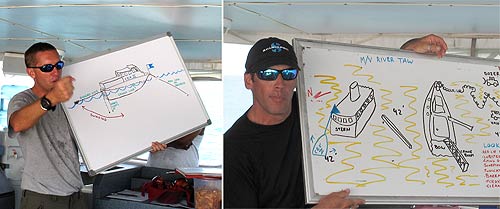
You get in the water by jumping in on the side. You get back on the boat via one of the ladders in the stern from where there are two short flight of stairs back up to the main deck. This is different from the Turks & Caicos boat where entry was from a dive platform in the stern. The main deck has two shower heads with hot water for warming up and rinsing off.
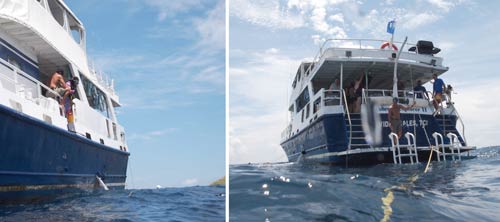
The captain's dive policy was maximum depth is 130 feet on air, 110 feet on nitrox. Maximum dive time 70 minutes, and come up with at least 500 psi left. Everyone must have a buddy unless they are solo diver certified (which no one was in our group). The boat has two ladders and also two weighted lines for 15-foot safety stops. Below you can see what it looks like from underwater.
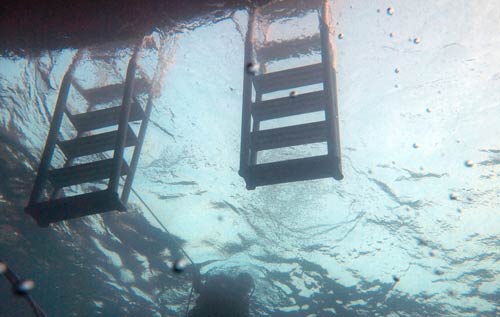
When the Caribbean Explorer is moored, the boat slowly swings back and forth around the anchor point, which means that as you get back to the starting point at the end of a dive, you may or may not see the boat, or it may move away and out of sight before you can catch one of the lines. The crew recommended to just wait until it comes back, as it always will. You can also grab the line and go along for the ride, which means you have to hang on to your hat. The ride can be a lot of fun as you're flying through the water, perusing the seascape below, but it can also be a bit disconcerting and time-consuming to locate the boat. However, the Caribbean Explorer swings far less than the Turks and Caicos boat.
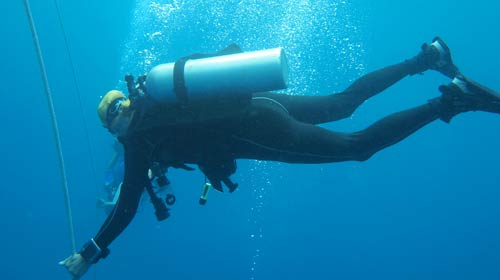
Air: The boat has its own compressor system. Tanks are filled by the crew with compressor hose whips right where they are standing in their retainer brackets after you take the BC/tank off after a dive. You never have to take the BC off or carry the tank around. All tanks are standard 80 cubic-foot aluminum cylinders with US standard Yoke valves. Tanks are in good condition.
32% Nitrox is available on the Caribbean Explorer II. If you use nitrox the entire trip, the flat rate is US$150 per diver. If you use it by the tank, it's US$10 per tank. If you do the maximum number of dives, the flat rate is a great deal. The per tank charge is high considering that most dive shops only charge $4 more per tank of nitrox. A nitrox tester is, of course, available and nitrox users must test and sign for each tank. Nitrox bottles have green valve caps, air bottles blue ones.
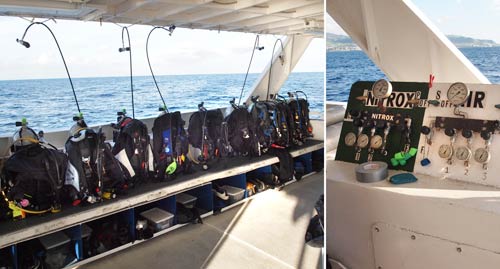
Weights: Lead weights are available onboard in whatever denomination you need.
Rental equipment: On a liveaboard, divers bring their own gear. The Caribbean Explorer II, however, does have some spare parts and a full line of Scubapro equipment in case someone forgets something or something breaks.
Diving: Carol had been on this boat in 2003 and had excellent memories of the diving and very good visibiity. Unfortunately, we weren't so lucky this time. While hurricane Igor had missed the islands by a few hundred miles, the size of the storm meant residual gusts, clouding, sporadic thunder showers, and choppy water. All this made for poor visibility in most areas, and we usually had to descend down the anchor line through 30 or 40 feet of very poor visibility to find better conditions at the bottom, though never more than perhaps 50-75 feet of visibility
What we saw was a nice mix of (fairly recent) wrecks, reefs, walls and sandy areas. We never ran into other divers and the dive sites were never crowded, there was great macro life with squat shrimp, sea lettuce, jawfish, blennies, nudibranchs, flamingo tongues, seahorses, garden eels, etc. We saw a few nurse sharks, a reef shark, octopus, jacks, moray eels, barracudas, many turtles and stingrays, but few other pelagics. Some dive sites had apparently suffered quite a bit of hurricane damage that will take time to heal, and some of the sites off St. Kitts had a disappointing amount of garbage. Some sites had a good deal of mud and silt, with only sponges peeking through and staying clean. Since the islands are vulcanic, we saw a lot of the clean, darkish volcanic sand. We were unable to dive one of Saba's signature sites, Eye of the Needle, due to very strong current. The captain also often had to hunt for dive sites with acceptable visibility and water conditions. By all accounts, our trip was not really representative of the wonderful diving that can usually be had here.
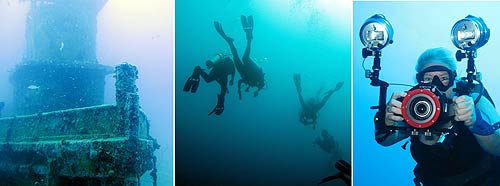
Below are the dive sites we visited, including my max depths on each.
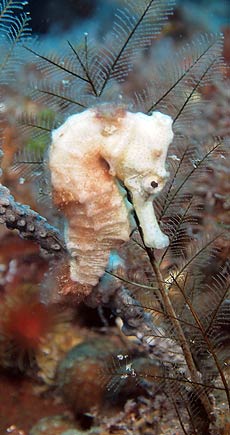 Sunday: St. Kitts:
Sunday: St. Kitts:
- River Taw wreck (43 feet)
- Corinthian wreck (2) (68 feet)
- Monkey Shaols (40 feet)
Monday: St. Kitts:
- Paradise Reef (2) (104 and 79 feet)
- Anchors Away (70 feet)
Tuesday: Saba:
- Tent Wall (2) (124 and 107 feet)
- Custom House (107 feet)
Wednesday: Saba:
- Custom House (100 feet)
- Tent Reef (2) (38 and 64 feet)
- Torrens Point (27 feet)
Thursday: Saba:
- Labyrinth (77 feet)
- Tent Reef (29 feet)
Friday: Saba:
- 3rd Encounter (aborted due to current)
- Diamond Rock (81 feet)
Note that no two liveaboard trips will likely ever be the same as weather and other conditions may determine where the captain will take the boat. We spent two days off the coast of St. Kitts and on the shoals between St. Kitts and Nevis. Then three and a half days off and around Saba, a small island that's about 28 miles northeast of St. Kitts. Both islands are of vulcanic nature, which means they are tall, wild and rocky. St. Kitts has some commercial development, Saba, which is almost inaccessible, almost none. St. Kitts/Nevis is a former British colony and now independent, and they have yet to see the wisdom in establishing a marine park and keeping things neat; Saba is quite pristine and does have a marine park. Below is the Caribbean Explorer off St. Kitts.
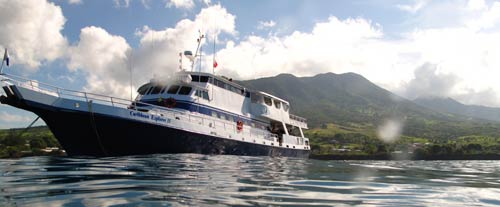
The island of Saba is a sight to behold, and it's not surprising that part of the original King Kong movie was supposedly recorded here. To the right you can see "Diamond Rock," one of Saba's signature dives.
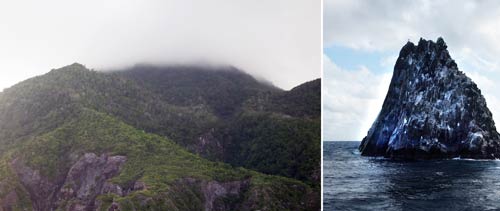
For some reason, the Caribbean Explorer now skips the island of St. Eustatius (or just "Statia"). It houses a big port and some refineries, but also a lot of history and good diving. We asked why it's now skipped, but got no good answer.
The image below shows some of the craggy rocks and spires at Saba. There is some awesome diving there, if you only get the water conditions right.
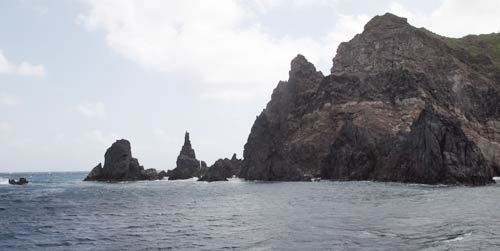
One thing we fortunately didn't see here were lionfish. Those colorful, exotic creatures are an invasive species in this part of the world, and as of 2010, we'd seen them at Turks & Caicos, Cozumel and Roatan. None around Saba and St. Kitts so far, but it's likely just a matter of time.
Sharks: For me, one of the highlights of Explorer Ventures' Turks & Caicos route had been the numerous sharks we'd seen there. Around Saba and St. Kitts we did see a few nurse sharks, but only a single reef shark in the distance.
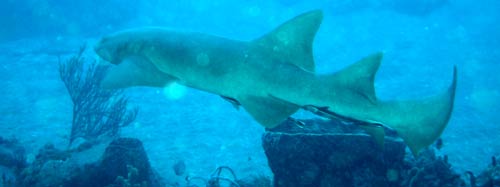
Fish life varied from site to site, with some being rather sparsely populated whereas others, and in particular the shallow reefs, were teeming with life. We did see an abundance of sting rays, including one giant one, lots of garden eels, jacks and a good number of barracudas and turtles.
Electricity: Electricity is generated onboard and totally reliable. There were several US standard 110 Volt three-prong outlets in our room. For fire safety reasons you're not supposed to leave stuff plugged in while you're not in the room, which can be a logistics problem when you have a lot of computer and camera gear. The boat had a "charging station" on the dive deck.
Computers/Internet: There is no internet access on the boat, so while you're underway you're blissfully cut off from the world. No internet access when docked at the St. Kitts marina either; in St. Maarten there are plenty of internet hotspots near the marina.
Cellphones: Unless you make prior arrangement with your cellphone vendor for international coverage, you won't be able to use your phone. For a charge you can use the boat's satellite phone, or you can bring your own satellite phone. I tried to use the iPhone as a GPS, but that didn't work.
Security: The St. Kitts marina is right in town, but there's a massive locked barbed wire fence so everything seems safe even while docked. Once underway, the boat's completely safe. We never even locked our door.
Vendors: There is no shop onboard, and there isn't one at the marinas either. If you want to buy souvenirs, you have to do it either before you get to the marina in St. Kitts, or during dinner in St. Maarten the last evening. The land tours offer limited opportunity to shop (Saba more so than St. Kitts). The boat does have a "boatique" where you could buy a variety of T-shirts, shirts, hoodies, sweats, chammyz, etc., with a variety of pertaining embroidering and printing (at relatively high prices, though). St. Maarten has excellent shopping within walking distance of the boat, ranging from very inexpensive apparel and trinkets to the most exclusive designer brands.
Weather: Do realize that the Northeastern Carribean is far from land and quite exposed. This means that you may or may not encounter weather that can affect diving and conditions. June through November is hurricane season. On Carol's trip on this boat in 2003, she encountered perfect conditions and exceptional visibility in August. On our trip in September of 2010, fallout from hurricane Igor meant choppy, churned up waters and the captain often had to search for sites with enough visibility and low current.
Cost: The per person list price for a week on the Caribbean Explorer II is US$1,895 for all main and lower deck rooms (pricing for July 2010 through April 2011). We also paid a US$95 fuel surcharge per person, US$115 port and marina park fees per person, transportation to and from the marina, etc., so the extras can add up. There was no departure tax on St. Maarten. At least marine park and fuel charges should be included in the overall price. Still, given the amount of diving you get to do and being on what really amounts to a yacht, a very good deal.
Tips: There are no hard recommendations, but the expectation is that you're paying a tip of 10-15% of the total package price (not including flight, obviously) at the end of the trip when you do your final settlement with the purser. That goes into a pot which will then be distributed among all crew. As always, if you're particularly pleased with someone, you can tip them separately.
Above is an aerial view of the small Caribbean islands of Saba, Statia, and St. Kitts that are located about 200 miles east of Puerto Rico. This is where Explorer Ventures' vessel Caribbean Explorer II offers liveaboard dive vacations. Imagine: seven days on a ship specifically equipped for diving, and as many as five dives every day!
Bottom Line: Explorer Ventures' Caribbean Explorer II is a 115 feet liveaboard vessel that offers easy and enjoyable access to numerous dive sites around the islands of St. Kitts and Saba. A great crew, excellent food, adequate facilities and usually five dives every day (weather permitting, and if you're up to it!) make this weeklong trip unforgettable (even in iffy weather and water conditions, as we had). Pricing is reasonable, dive sites diverse and the land tours fascinating treats. No other liveaboards are offering these islands year-round.
Contact: www.explorerventures.com
